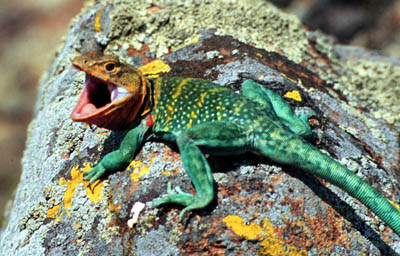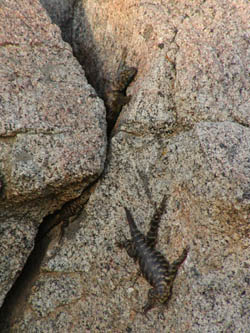 |
|
| Home ~ Research ~ Publications ~ Home Life ~ Contact Info | |
Research Interests General |
||
Dissertation
Research First, as in earlier studies, treadmill endurance provided a direct measure physical prowess. Direct measures of physical prowess are lacking in many of the classic signaling studies, such as roaring by Red deer stags, or stotting by gazelles. I found a robust relationship between endurance and the duration of threat posturing in lizards, whereas push-up frequency was only weakly related to endurance. Second, by imposing treadmill exercise, endurance can be directly manipulated. Compared with baseline displays, threat posture duration was significantly reduced after treadmill exercise, whereas push-up production was not. A detailed analysis of push-up attributes, conducted with the help of J. Ryan Allen, revealed individually distinctive signatures that persist in spite of experimentally induced fatigue, suggesting that push-up structure can advertise individual identity. Third, treadmill performance can be used to measure signal costs, by comparing baseline endurance to endurance levels after display production. Lizards experienced a significant endurance decrement as a consequence of display production. I hypothesized that threat posturing functions as a quality handicap, a signal that uses up the very attribute that is being signaled, perhaps by interfering with respiration. Consistent with my hypothesis, I found that lactate levels were higher in the post-display condition than in the baseline condition. Barry Sinervo and I examined the effect of familiarity on the relative importance of endurance capacity and throat color badges in predicting dominance. We found that among un-familiar individuals, throat color predicted dominance, whereas among familiar individuals, endurance predicted dominance. These results suggest that lizards can flexibly switch between assessment tactics, based on the availability of previous information. |
||
Postdoctoral
Research |
Granite spiny lizards (Sceloporus orcutti): male (top), female (bottom) and juvenile (in the crack), Sycamore Canyon Park, Riverside, California. |
|
| Crotaphytus
Project (back to top) In collaboration with Joe Macedonia, Kris Lappin, Jerry Husak, and David Clark, we have been examining population differences in coloration, size, and bite force of common collared lizards (Crotaphytus collaris) as they relate to crypsis, diet and sexual selection. We are also examining individual variation in performance and signal variables, and the potential of color patches to act as amplifiers (sensu Hasson) of threat displays. |
 Common
collared lizard, Wichita Mountains, Oklahoma Common
collared lizard, Wichita Mountains, Oklahoma |
|
